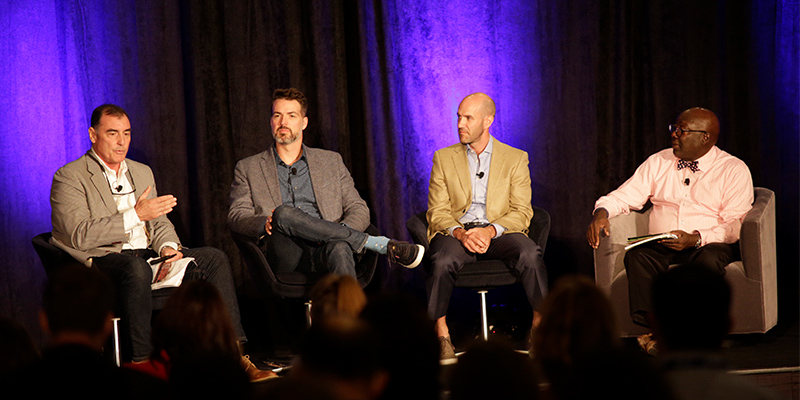In his keynote address at FlexOffice 2018, hosted by NAIOP and the Global Workspace Association, Antony Slumbers noted that Apple sells 18 percent of the world’s smartphones, but reaps 82 percent of the revenue from the sale of smartphones. Any company would love to have that 82 percent market share.
When it comes to flexible workspaces, many small operators are trying to grow their positions, even if they can’t scale to Apple’s level of market share. At a panel moderated by Benjamin Dyett, partner at The DecoGroup, owners and operators discussed how they are expanding their coworking businesses.
Ken Cope is president of REth!nk. He said that entering the shared workspace business was a revelation. When he was opening his first shared space, he said he wondered why he’d ever wanted to work in traditional real estate. His company now operates buildings in Denver and Houston, and plans to open other locations.
Cope said there are pros and cons to owning shared spaces. The advantages include:
- Control over the space. The owner decides what businesses go in.
- Higher returns.
- More exit options. If businesses in the building fail, owners can do other things with the space.
- Relationships with tenants.
However, he warned, there are disadvantages:
- Capital-intensive. It’s expensive.
- Higher risk. Many startups will fail.
- Learning curve. You don’t know what you don’t know about coworking.
- Time intensiveness.
For Cope, the bottom line is, well, the bottom line. He said his first two projects are very profitable, delivering more profit than a traditional project would.
For his part, Joshua Fine, executive vice president and general counsel at Focus Property Group, said his company decided to move into the coworking space when it bought a crumbling building in Denver. It has since added two other properties in that city.
“We were able to go into a building that had 25 percent vacancy and know that because of coworking, we would have 100 percent occupancy at closing,” he said. That made obtaining funding much easier.
Daniel Levison is principal at Atlanta Investment Properties, SharedSpace and CommissionTrac. He said his company looks for buildings it could use for shared space. He said the coworking model is working so well for SharedSpace that it is expanding. “We had a brokerage company taking half of a floor, and the coworking space went so well we ended up taking that space for coworking.” His company’s model also involves taking up buildings that are underfilled and turning them into coworking spaces.
Dyett asked panelists how they convince lenders that coworking can be profitable. Cope said that smaller coworking providers should focus on delivering value. Focus on what amenities you can provide. Fine added that smaller providers can zero in on smaller projects. In some places, providing just one or two floors as coworking spaces can be extremely profitable. The Net Operating Income of a coworking space can be three times what it would be in a traditional building, he said.
“What we’re seeing is a real shift from providing real estate as a product to providing a service that helps people grow their business,” Dyett said. Of course, branding is important. “It’s almost like a franchise,” Levison said. People need to know they’ll be getting quality spaces to work in. One SharedSpace facility is located along an interstate in Atlanta, giving the company good visibility.
The most important thing the panelists explained is you don’t have to be the biggest provider to succeed as a coworking operator. They say that striving to be the best can deliver success and profitability in this growing market space.














